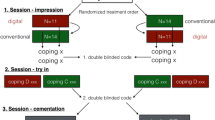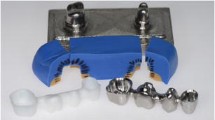Abstract
The aim of the present in vitro study was to evaluate the influence of different processing routes on the fitting accuracy of four-unit zirconia fixed dental prostheses (FDPs) fabricated by computer-aided design/computer-aided manufacturing (CAD/CAM). Three groups of zirconia frameworks with ten specimens each were fabricated. Frameworks of one group (CerconCAM) were produced by means of a laboratory CAM-only system. The other frameworks were made with different CAD/CAM systems; on the one hand by in-laboratory production (CerconCAD/CAM) and on the other hand by centralized production in a milling center (Compartis) after forwarding geometrical data. Frameworks were then veneered with the recommended ceramics, and marginal accuracy was determined using a replica technique. Horizontal marginal discrepancy, vertical marginal discrepancy, absolute marginal discrepancy, and marginal gap were evaluated. Statistical analyses were performed by one-way analysis of variance (ANOVA), with the level of significance chosen at 0.05. Mean horizontal discrepancies ranged between 22 μm (CerconCAM) and 58 μm (Compartis), vertical discrepancies ranged between 63 μm (CerconCAD/CAM) and 162 μm (CerconCAM), and absolute marginal discrepancies ranged between 94 μm (CerconCAD/CAM) and 181 μm (CerconCAM). The marginal gap varied between 72 μm (CerconCAD/CAM) and 112 μm (CerconCAM, Compartis). Statistical analysis revealed that, with all measurements, the marginal accuracy of the zirconia FDPs was significantly influenced by the processing route used (p < 0.05). Within the limitations of this study, all restorations showed a clinically acceptable marginal accuracy; however, the results suggest that the CAD/CAM systems are more precise than the CAM-only system for the manufacture of four-unit FDPs.





Similar content being viewed by others
References
Hannink RHJ, Kelly PM, Muddle BC (2000) Transformation toughening in zirconia-containing ceramics. J Am Ceram Soc 83:461–487
Kohorst P, Dittmer MP, Borchers L, Stiesch-Scholz M (2008) Influence of cyclic fatigue in water on the load-bearing capacity of dental bridges made of zirconia. Acta Biomater 4:1440–1447
Kohorst P, Herzog TJ, Borchers L, Stiesch-Scholz M (2007) Load-bearing capacity of all-ceramic posterior four-unit fixed partial dentures with different zirconia frameworks. Eur J Oral Sci 115:161–166
Tinschert J, Natt G, Hassenpflug S, Spiekermann H (2004) Status of current CAD/CAM technology in dental medicine. Int J Comput Dent 7:25–45
Raigrodski AJ (2004) Contemporary materials and technologies for all-ceramic fixed partial dentures: a review of the literature. J Prosthet Dent 92:557–562
Denry I, Kelly JR (2008) State of the art of zirconia dental applications. Dent Mater 24:299–307
Rosentritt M, Behr M, Thaller C, Rudolph H, Feilzer A (2009) Fracture performance of computer-aided manufactured zirconia and alloy crowns. Quintessence Int 40:655–662
Comlekoglu M, Dundar M, Ozcan M, Gungor MA, Gokce B, Artunc C (2009) Influence of cervical finish line type on the marginal adaptation of zirconia ceramic crowns. Oper Dent 34:586–592
Castillo de Oyagüe R, Sánchez-Jorge MI, Sánchez Turrión A, Monticelli F, Toledano M, Osorio R (2009) Influence of CAM vs. CAD/CAM scanning methods and finish line of tooth preparation in the vertical misfit of zirconia bridge structures. Am J Dent 22:79–83
Sailer I, Feher A, Filser F, Gauckler L, Lüthy H, Hämmerle CH (2007) Five-year clinical results of zirconia frameworks for posterior fixed partial dentures. Int J Prosthodont 20:383–388
Lang NP, Kiel RA, Anderhalden K (1983) Clinical and microbiological effects of subgingival restorations with overhanging or clinically perfect margins. J Clin Periodontol 10:563–578
Koernschild KL, Campbell SD (2000) Periodontal tissue responses after insertion of artificial crowns and fixed partial dentures. J Prosthet Dent 84:492–498
Felton DA, Kanoy BE, Bayne SC, Wirthman GP (1991) Effect of in vivo crown margin discrepancies on periodontal health. J Prosthet Dent 65:357–364
Goldman M, Laosonthorn P, White RR (1992) Microleakage—full crowns and the dental pulp. J Endod 18:473–475
Rekow D, Thompson VP (2005) Near-surface damage—a persistent problem in crowns obtained by computer-aided design and manufacturing. Proc Inst Mech Eng 219:233–243
Molin MK, Karlsson SL (2008) Five-year clinical prospective evaluation of zirconia-based Denzir 3-unit FPDs. Int J Prosthodont 21:223–227
Tinschert J, Schulze KA, Natt G, Latzke P, Heussen N, Spiekermann H (2008) Clinical behavior of zirconia-based fixed partial dentures made of DC-Zirkon: 3-year results. Int J Prosthodont 21:217–222
Vult von Steyern P, Carlson P, Nilner K (2005) All-ceramic fixed partial dentures designed according to the DC-Zirkon technique. A 2-year clinical study. J Oral Rehabil 32:180–187
Reich S, Kappe K, Teschner H, Schmitt J (2008) Clinical fit of four-unit zirconia posterior fixed dental prostheses. Eur J Oral Sci 116:579–584
Beuer F, Aggstaller H, Edelhoff D, Gernet W, Sorensen J (2009) Marginal and internal fits of fixed dental prostheses zirconia retainers. Dent Mater 25:94–102
Beuer F, Naumann M, Gernet W, Sorensen JA (2008) Precision of fit: zirconia three-unit fixed dental prostheses. Clin Oral Investig 13:343–349
Tinschert J, Natt G, Mautsch W, Spiekermann H, Anusavice KJ (2001) Marginal fit of alumina- and zirconia-based fixed partial dentures produced by a CAD/CAM system. Oper Dent 26:367–374
Reich S, Wichmann M, Nkenke E, Proeschel P (2005) Clinical fit of all-ceramic three-unit fixed partial dentures, generated with three different CAD/CAM systems. Eur J Oral Sci 113:174–179
Wettstein F, Sailer I, Roos M, Hämmerle CHF (2008) Clinical study of the internal gaps of zirconia and metal frameworks for fixed partial dentures. Eur J Oral Sci 116:272–279
Bindl A, Mörmann WH (2007) Fit of all-ceramic posterior fixed partial denture frameworks in vitro. Int J Periodontics Restorative Dent 27:567–575
Gonzalo E, Suárez MJ, Serrano B, Lozano JF (2008) Marginal fit of zirconia posterior fixed partial dentures. Int J Prosthodont 21:398–399
Coli P, Karlsson S (2004) Precision of a CAD/CAM technique for the production of zirconium dioxide copings. Int J Prosthodont 17:577–580
Kohorst P, Brinkmann H, Li J, Borchers L, Stiesch M (2009) Marginal accuracy of four-unit zirconia fixed dental prostheses fabricated using different computer-aided design/computer-aided manufacturing systems. Eur J Oral Sci 117:319–325
Vigolo P, Fonzi F (2008) An in vitro evaluation of fit of zirconium-oxide-based ceramic four-unit fixed partial dentures, generated with three different CAD/CAM systems, before and after porcelain firing cycles and after glaze cycles. J Prosthodont 17:621–626
Att W, Komine F, Gerds T, Strub JR (2009) Marginal adaptation of three different zirconium dioxide three-unit fixed dental prostheses. J Prosthet Dent 101:239–247
Holmes JR, Bayne SC, Holland GA, Sulik WD (1989) Considerations in measurement of marginal fit. J Prosthet Dent 62:405–408
Kunii J, Hotta Y, Tamaki Y, Ozawa A, Kobayashi Y, Fujishima A, Miyazaki T, Fujiwara T (2007) Effect of sintering on the marginal and internal fit of CAD/CAM-fabricated zirconia frameworks. Dent Mater J 26:820–826
Persson ASK, Odén A, Andersson M, Sandborgh-Englund G (2009) Digitization of simulated clinical dental impressions: virtual three-dimensional analysis of exactness. Dent Mater 25:929–936
Witkowski S, Komine F, Gerds T (2006) Marginal accuracy of titanium copings fabricated by casting and CAD/CAM techniques. J Prosthet Dent 96:47–52
Komine F, Gerds T, Witkowski S, Strub JR (2005) Influence of framework configuration on the marginal adaption of zirconium dioxide ceramic anterior four-unit frameworks. Acta Odontol Scand 63:361–366
Dittmer MP, Borchers L, Stiesch M, Kohorst P (2009) Stresses and distortions within fixed dental prostheses due to the veneering process. Acta Biomater 5:3231–3239
Boening KW, Wolf BH, Schmidt AE, Kastner K, Walter MH (2000) Clinical fit of Procera AllCeram crowns. J Prosthet Dent 84:419–424
Coli P, Karlsson S (2004) Fit of a new pressure-sintered zirconium dioxide coping. Int J Prosthodont 17:59–64
Bornemann G, Lemelson S, Luthardt RG (2002) Innovative method for the analysis of the internal 3D fitting accuracy of Cerec-3 crowns. Int J Comput Dent 5:177–182
Luthardt RG, Bornemann G, Lemelson S, Walter MH, Hüls A (2004) An innovative method for evaluation of the 3-D internal fit of CAD/CAM crowns fabricated after direct optical versus indirect laser scan digitizing. Int J Prosthodont 17:680–685
Harris IR, Wickens JL (1994) A comparison of the fit of spark-eroded titanium copings and cast gold alloy copings. Int J Prosthodont 7:348–355
Laurent M, Scheer P, Dejou J, Laborde G (2008) Clinical evaluation of the marginal fit of cast crowns—validation of the silicone replica method. J Oral Rehabil 35:116–122
Rahme HY, Tehini GE, Adib SM, Ardo AS, Rifai KT (2008) In vitro evaluation of the “replica technique” in the measurement of the fit of Procera crowns. J Contemp Dent Pract 9:25–32
Groten M, Axmann D, Pröbster L, Weber H (2000) Determination of the minimum number of marginal gap measurements required for practical in vitro testing. J Prosthet Dent 83:40–49
Acknowledgements
This study was supported by DeguDent GmbH, which is gratefully acknowledged.
Conflict of interest
The authors declare that they have no conflict of interest.
Author information
Authors and Affiliations
Corresponding author
Rights and permissions
About this article
Cite this article
Kohorst, P., Junghanns, J., Dittmer, M.P. et al. Different CAD/CAM-processing routes for zirconia restorations: influence on fitting accuracy. Clin Oral Invest 15, 527–536 (2011). https://doi.org/10.1007/s00784-010-0415-9
Received:
Accepted:
Published:
Issue Date:
DOI: https://doi.org/10.1007/s00784-010-0415-9




